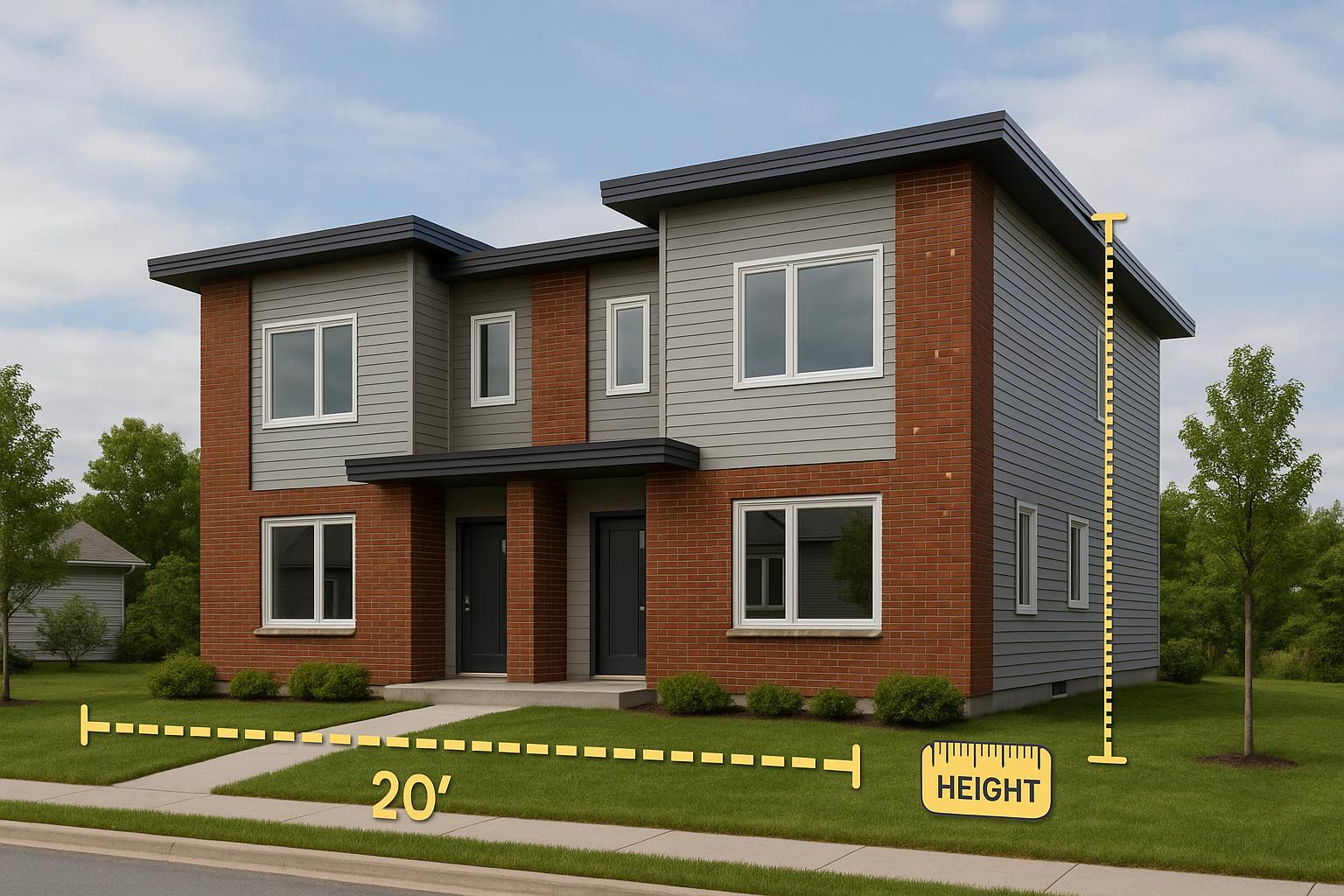Dartmouth's ER-3 zoning offers better investment returns than Halifax Peninsula properties. With predictable costs, faster project timelines, and growing rental demand, Dartmouth stands out as a more practical option for multi-unit developments. In contrast, Halifax Peninsula investments face higher land costs, stricter regulations, and longer timelines, which can reduce profitability.
Key Insights:
-
Dartmouth ER-3 Advantages:
- Lower land costs.
- Fixed-price construction averaging $160,000/unit.
- Annual ROI between 12%–20%.
- Shorter 6-month project timelines with fewer delays.
- Steady rental demand with rents of $1,950–$2,100/unit.
- Strong upward rent growth.
-
Halifax Peninsula Challenges:
- Higher land prices.
- Complex zoning rules and heritage restrictions.
- Longer project timelines (beyond 6 months).
- Increased development costs and reduced ROI despite higher rents.
-
Construction Impact:
- Integrated design-build methods in Dartmouth minimize delays, control costs, and improve ROI.
- Halifax’s fragmented construction processes often lead to 30%–60% budget overruns.
Quick Comparison:
| Factor | Dartmouth ER-3 | Halifax Peninsula |
|---|---|---|
| Land Costs | Lower | Higher |
| Construction Costs | Predictable | Higher, variable |
| Project Timelines | ~6 months | Extended |
| Initial Rent Potential | $1,950–$2,100/unit | Higher rents |
| ROI | 12%–20% | Lower due to costs |
Dartmouth’s ER-3 zoning is ideal for long-term growth, while Halifax Peninsula suits those prioritizing immediate cash flow. For investors aiming to maximize ROI with fewer risks, Dartmouth is the better choice.
Dartmouth, Nova Scotia: Is it a Good Place to Live in 2025?
1. Dartmouth ER-3 Zoning
Dartmouth's ER-3 zoning, part of the Centre Plan's Established Residential framework, provides a clear structure for multi-unit residential developments in established urban areas. It’s designed to balance growth with the existing community fabric.
This zoning allows developers to plan multi-unit projects with defined parameters that fit seamlessly into the surrounding infrastructure. With existing utilities already in place and specific requirements - such as parking and setback standards - developers can avoid many of the surprises that often lead to increased costs or delays.
For property owners, ER-3 zoning offers a straightforward guide to creating developments that align with both community expectations and municipal regulations. This predictability stands in contrast to the uncertainties often faced by those developing properties on the Halifax Peninsula. Up next, we’ll dive into how the dynamics of Halifax Peninsula properties compare and the potential return on investment (ROI) advantages offered by Dartmouth’s ER-3 zoning.
2. Halifax Peninsula Properties
Developing multi-unit properties on the Halifax Peninsula comes with its own set of challenges, largely due to strict zoning rules, density caps, design requirements, and heritage preservation policies. These regulations, while ensuring the area retains its character, can make projects more complicated. Factors like mandatory parking spaces, building height restrictions, and required infrastructure upgrades further add to the complexity. While these measures may help support higher rental rates, they also significantly increase development costs, which in turn can reduce the return on investment (ROI) compared to areas with more flexible guidelines.
For developers, these rules mean project designs and timelines must carefully account for the added regulatory hurdles. The rigidity of these requirements often results in higher costs and lower ROI, especially when compared to the more accommodating ER-3 zoning in Dartmouth.
This regulatory landscape sets the stage for a closer examination of costs and ROI between Halifax Peninsula properties and those in Dartmouth's ER-3 zone.
Cost Comparison and Returns
When you break it down, the Dartmouth ER-3 stands out for its financial advantages. With its integrated design-build approach, property owners can count on fixed-price construction costs, averaging around $160,000 per unit for a four-unit development. Pair that with monthly rents ranging from $1,950 to $2,100 per unit, and you're looking at annual returns of 12% to 20%. That level of predictability and profitability is hard to ignore.
On the other hand, traditional construction methods often come with a higher price tag. The fragmented process - multiple contracts, added regulatory hurdles, and fluctuating budgets - tends to drive up costs. While these projects might occasionally command slightly higher rents, the increased upfront capital needed often eats into the return on investment, making them less appealing overall.
Rental Market Analysis
Dartmouth's rental market thrives on strong tenant demand for affordable housing with convenient access to Halifax. The area attracts a mix of young professionals and families, creating steady demand for well-thought-out rental units. Two-bedroom layouts, in particular, are highly sought after, offering a balance of space and affordability.
On the other hand, the Halifax Peninsula presents a different set of challenges. Its rental market features a mix of older apartment buildings, heritage homes, and newer condo developments. This diversity in housing options intensifies competition, leading to longer vacancy periods and the need for landlords to offer incentives to attract tenants.
Dartmouth developments stand out by incorporating modern construction techniques, energy-efficient systems, and high-quality finishes. These features not only enhance tenant satisfaction but also lower operating costs for property owners. As a result, occupancy levels remain strong, and landlords can manage expenses more effectively.
Rental rate trends also differ between the two areas. Dartmouth properties allow for gradual rent increases, while properties on the Peninsula often face competitive pricing pressures and regulatory constraints, which can make tenant retention more challenging.
Dartmouth's appeal is further strengthened by its reliable transit options, including ferries and buses, making it an attractive choice for commuters. These factors collectively position Dartmouth as a more favourable market for investment.
With its lower costs, consistent demand, and modern construction practices, Dartmouth offers better long-term returns compared to the more complex and competitive market of the Halifax Peninsula.
sbb-itb-16b8a48
Construction Methods Impact on ROI
Dartmouth's cost and rental market advantages are just part of the equation when it comes to maximizing your ROI. The construction method you choose plays a huge role in determining your financial outcomes.
Take separately managed contracts, for instance. This approach involves hiring individual contractors for design, engineering, permits, and construction. While it may seem straightforward, it often leads to budget overruns of 30–60% and can stretch project timelines from 8 months to over 18 months. The lack of coordination among various professionals is a common culprit here.
Now compare that to integrated design-build methods, where planners, architects, engineers, and construction teams work together under one umbrella. This streamlined approach eliminates the headaches of managing unaligned teams, resulting in better cost predictability and fewer budget surprises.
Timeline certainty is another key consideration. For example, Helio Urban Development guarantees project completion within 6 months and even imposes penalties of $1,000 per day for delays. This matters because every month of delay can cost you approximately $8,000 per fourplex, assuming a monthly rent of $2,000 per unit.
Another advantage of integrated methods is the use of fixed-price contracts, which lock in costs upfront. When Helio quotes $160,000 per unit for standard construction, that price remains steady, no matter what happens with material costs or labour challenges. This stability allows property owners to confidently plan their ROI, without worrying about unexpected financial hits. Additionally, the quality consistency of a unified approach reduces maintenance costs and extends the building’s lifespan, unlike fragmented methods that often lead to uneven standards and higher repair expenses.
Dartmouth’s focus on operational efficiency aligns perfectly with the benefits of a single, accountable team. By streamlining project management, property owners avoid juggling multiple contracts or resolving disputes among various trades. This efficiency translates to an average savings of $47,000 in coordination costs per project.
For ER-3 developments in Dartmouth, meeting zoning requirements - like height limits, lot coverage, and design standards - is critical. Integrated design-build methods minimize the risk of costly compliance issues by ensuring precise coordination. This approach helps you avoid delays, so your building opens on time and you can start collecting rent without setbacks.
When evaluating construction methods, it’s clear that firms with integrated design-build experience, fixed-price contracts, and strict timeline guarantees offer the best path to maximizing ROI for ER-3 projects.
Advantages and Drawbacks
When deciding between investing in Dartmouth ER-3 or Halifax Peninsula properties, it's essential to weigh the unique benefits and challenges each location offers. Key factors like cost, construction complexity, and market dynamics play a crucial role in shaping your return on investment (ROI).
Dartmouth ER-3 advantages are rooted in affordability and growth potential. Land in this area comes at a much lower cost, making it easier to enter the market with less upfront investment. The zoning rules here allow for four-storey developments, enabling higher rental density. Interestingly, Dartmouth posted the highest rent growth rate among Halifax subregions in 2024, even though rents started from a lower baseline [1]. This trend points to strong potential for future property value appreciation.
Halifax Peninsula advantages focus on established rental premiums. Properties in this area typically command higher monthly rents from the start, making them attractive to investors looking for quicker cash flow. Its proximity to downtown Halifax, major universities, and employment hubs ensures a steady demand for rentals and long-term value stability.
On the flip side, Peninsula drawbacks include the steep cost of land, which can significantly impact ROI. Complex zoning regulations and heritage preservation requirements often lead to longer project timelines, sometimes exceeding the typical six-month window. Additionally, navigating municipal processes can result in budget overruns, ranging from 30% to 60%. These challenges highlight the importance of a well-integrated construction strategy.
Dartmouth's primary limitation is its lower starting rental income. While the growth rates are promising, the initial monthly rents lag behind what Peninsula properties can achieve.
| Factor | Dartmouth ER-3 | Halifax Peninsula |
|---|---|---|
| Land Costs | Much lower | Premium pricing |
| Construction Complexity | Easier zoning compliance | Complicated heritage/zoning |
| Initial Rent Potential | Lower starting point, high growth | Higher immediate returns |
| Timeline Risk | 6-month completion possible | Extended approval times |
| ROI Timeline | Faster to break even | Longer capital recovery |
| Market Trajectory | Strong upward momentum | Stable but slower growth |
This comparison highlights how these factors influence ROI and timelines differently.
In 2024, Halifax's apartment vacancy rate rose to 2.1% [1]. However, Dartmouth's lower entry costs provide a cushion against market shifts.
Ultimately, the choice between these two markets depends on your investment goals. Dartmouth ER-3 is ideal for those looking to scale their portfolio with higher ROI potential over time. Meanwhile, the Halifax Peninsula appeals to investors prioritizing immediate cash flow and a foothold in an established market. Whether you're aiming for long-term growth or quicker returns, each option aligns with distinct investment strategies.
Conclusion
The analysis leaves little room for doubt - Dartmouth's ER-3 investments consistently deliver strong returns. With annual ROIs ranging from 12% to 20%, supported by fixed-price, on-time construction, the numbers make a compelling case.
Dartmouth ER-3's integrated construction model is a game-changer, cutting budget overruns by 30–60% and ensuring projects are completed within six months. This approach not only safeguards your investment timeline but also stands out compared to Halifax Peninsula, thanks to favourable zoning and steady rental demand.
Energy efficiency upgrades add another layer of profitability. Take one Dartmouth project as an example: an investment of around $61,000 in energy upgrades resulted in 80% of the cost being recouped through rebates and a payback period of less than two years [2]. This demonstrates how smart, proactive upgrades can significantly enhance returns.
To maximize these benefits, property owners should apply for energy efficiency rebates early in the process. Buildings with four or more units are eligible for detailed energy assessments and pre-approved upgrades, making it easier to plan. Additionally, working with an integrated construction team eliminates inefficiencies and keeps projects on track. This is crucial, as rental income delays on a typical fourplex can cost about $8,800 per month.
In short, Dartmouth's ER-3 zone offers a winning combination: reliable timelines, streamlined construction, and attractive energy incentives - all of which contribute to higher long-term returns for rental property investors.
FAQs
Why is Dartmouth's ER-3 zoning a better choice for multi-unit residential investments than the Halifax Peninsula?
Dartmouth's ER-3 zoning stands out as a smart option for those eyeing multi-unit residential investments, thanks to its higher-density permissions. This zoning allows for developments like 8-unit buildings and townhouses with fewer hurdles, giving property owners more flexibility to make the most of their land.
On top of that, land prices and construction costs in Dartmouth tend to be lower compared to the Halifax Peninsula. This means you can launch projects with a smaller initial investment. Pair that affordability with strong rental demand and Dartmouth's convenient proximity to Halifax, and you have a recipe for strong potential returns. For anyone aiming to build profitable rental properties, Dartmouth offers an attractive balance of affordability and growth opportunities.
How do design-build methods in Dartmouth make construction more efficient and cost-effective?
Design-Build Methods in Dartmouth
In Dartmouth, design-build methods simplify the construction process by merging the design and building phases into one cohesive workflow. This integration allows tasks to overlap, cutting project timelines by about 12% and significantly reducing delays caused by unexpected change orders.
Another advantage of the design-build approach is its ability to keep budgets on track. Projects using this method see an average cost growth of only 3.8%, a stark contrast to the 10–15% overruns often associated with traditional construction methods. By streamlining communication and consolidating accountability, design-build provides property owners with a more efficient and budget-friendly way to complete multi-unit developments.
What challenges should I consider when investing in Dartmouth's ER-3 zone compared to the Halifax Peninsula?
Investing in Dartmouth's ER-3 zone presents a few hurdles. For one, land prices can be on the higher side, and zoning regulations are still evolving, which might lead to uncertainties in development schedules and rental demand. Plus, as Dartmouth continues to grow, its infrastructure capacity might need closer evaluation to ensure it can handle increased demand.
Meanwhile, the Halifax Peninsula's established ER-3 zone carries its own set of risks. The market here is more competitive, potentially due to saturation, and rental demand can fluctuate with the seasons. These factors might affect the consistency of your return on investment. Taking the time to carefully weigh the pros and cons of both locations will help you align your choice with your investment objectives and comfort with risk.



